Duggan has no right under state law to order Brush Park Plan
State and city bureaucrats destroyed BLACK Brush Park:
Historic homes and enterprises demolished, set on fire
At least 800 residents left homeless, with no relocation funds
By Ron Seigel
June 25, 2015
A few weeks ago Detroit Mayor Mike Duggan held a well-publicized press conference about an urban renewal project he claims will restore the historic Detroit area of Brush Park. That project is dominated by multi-billionaire Dan Gilbert’s Bedrock Real Estate.
The problem is that it is against the law for the Mayor or any city department to approve such a plan. Any city council member who votes for the plan or for that matter any urban renewal plans in any area whatsoever will be breaking the law.
State Act 344 Section (a)(6) states “A local commission, public agency, [such as a city]] or legislative body of any municipality shall not approve any development unless there has been consultation between…the officials responsible for the development” and the citizens district council (CDC) representing residents and businesses in the area where the development is taking place.
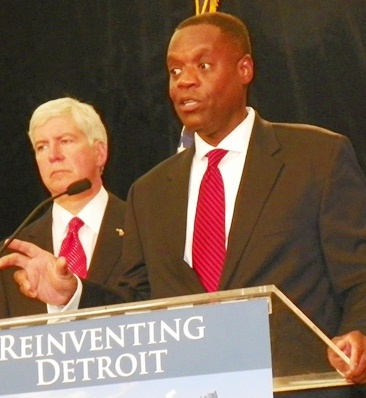
Detroit’s former EM Kevyn Orr with Michigan Gov. Rick Snyder at side announces plan for bankruptcy which has destroyed Detroit, on July 19, 2013. Orr abolished CDC’s on Sept. 22, 2014.
This is impossible, because in his closing days as Detroit’s emergency manager Kevyn Orr, appointed by Governor Rick Snyder, abolished all CDCs.
Neither Orr nor the Snyder Administration had any legal right to do so.
It may be arguable that under the recent legislation rammed through by Snyder’s Republican Party, Orr did have the authority to repeal every law in the City of Detroit whenever he wanted to. However, citizen district councils were established under state law. Orr, as a creature of state government, had no more legal power to interfere with state laws than his boss Governor Snyder has to shut down the state legislature. One might ponder whether the former emergency manager and the governor behind him need a lesson in high school civics.
A more compelling question is whether they have something they are desperately trying to hide.
Orr’s spokesperson, Bill Nowling, justified Orr’s actions by saying “It was felt CDCs represented an unnecessary level of bureaucracy that was hindering future development by revitalization efforts.”
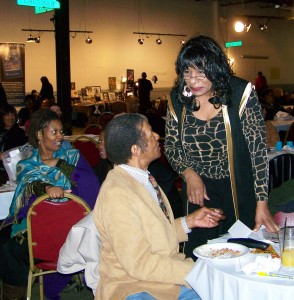
Gwen Mingo (r), formerly chair of Brush Park CDC, talks with Jimmy Cole at Call ‘Em ‘Out dinner Feb. 25, 2012.
Actually citizen district councils had no power to stop or even delay any development whatsoever. The law set them up as an advisory body so those in the area have a chance to voice their concerns about what the government was doing to their area.
They could in no way be considered a bureaucracy.
What probably frightened Orr and Snyder was that CDC’s could occasionally try to use the influence of private citizens with their elected representatives to prevent the real bureaucrats, the ones in government, from doing whatever they wanted whenever they wanted. Perhaps most frightening of all, under state law the private citizens had the right to know what the bureaucrats were doing.
Historically in past urban renewal projects it was the state and city bureaucrats which ruined Brush Park. As Father Norman Thomas, Pastor of the nearby Sacred Heart Church, said, “It’s the most terrible thing I’ve ever seen.”
The government bureaucrats committed illegalities all along the way. The Brush Park CDC’s asked for an investigation by a federal grand jury. It seems clear why the bureaucrats may not want them around. Looking at the record:
STATE OFFICIALS DESTROYED THE AREA’S BUSINESSES
Several decades ago Brush Park had a prosperous business district on Hastings Street and a popular entertainment district called Paradise Valley. The owners just happened to be Black.
“It was a high period of Black culture,” Dorothy Robinson, a playwright and the owner of a theatrical group, said regarding the area’s entertainment district. “There would always be excitement and a variety of things going on. ”
She added, “When we had anything, white people came to see it. They were not so prejudiced that they did not enjoy Black entertainment.” State officials just happened to build the Chrysler Expressway (I-75) right in the middle of the Black business area.
In an interview 10 years ago William Worden, then Director of the Detroit Historic Advisory Board, stated, “The common view is that this was not done inadvertently.”
Douglas Fuller, a lifelong Brush Park resident, said, “The kids don’t know the pride we had or how it felt. There is no more evidence of where we came from or what we did here.”
The businessmen authorized to “revitalize” Brush Park are not the ones who were displaced, but a new group of outsiders.
The Orr-Snyder Machine may call this free enterprise, but it seems more like free loading.
BUREAUCRATS ILLEGALLY DESTROYED HISTORIC BUILDINGS
While city bureaucrats may talk of restoring city buildings, it was the bureaucrats who were responsible for illegally destroying them. Some were private houses. Some had significance in Black history, like the original stand for the first African-American taxi cab company in Detroit, and buildings in the entertainment district. They also destroyed one building that once belonged to the infamous Purple Gang.
On hearing about this, one man quipped,”They don’t even have respect for fellow gangsters.”
In 2003 state bureaucrats joined in the demolition with funds from the Michigan Department of Environmental Quality (MDEQ) under the pretext of its Clean Energy Program.
The Brush Park CDC wrote to MDEQ, “It is criminal, outrageous, and an abomination to demolish these properties.”
At a time when so many neighborhoods were pleading in vain for the demolition of vacant houses that they considered eyesores or positively dangerous, why were taxpayer dollars being used to demolish houses in the one area where residents wanted them to stay?
When spokespersons for state and city officials were asked about this, they promptly passed responsibility to those on other levels. Liz Boyd, spokesperson for former Michigan Governor Jennifer Granholm, said this was a matter for the MDEQ.
MDEQ spokesperson Patricia Spetzley stated, “The City of Detroit prioritizes what is torn down with state tax dollars. The residents should go to the Mayor. ” Ironically, professed concern from the Granholm administration about cities setting priorities did not prevent Granholm a few years later from advocating that state appointed managers of local governmental bodies be given powers beyond financial issues and control all policies — paving the way for the reign of Kevyn Orr.
Just as ironically the spokesperson for Detroit’s mayor, then Kwame Kilpatrick, indicated that it might not be any use for residents to go to his boss. Kilpatrick’s spokesperson Howard Hughey said the Mayor did not care to know where state environmental funds were going, but was leaving these things up to the city’s Planning and Development Department (P&DD).
Hughey declared, “It’s not a mayoral issue, but a P&DD issue. The P&DD submits their plan for making the city cleaner. The Mayor has perfect confidence in those he put in leadership positions. It doesn’t go from the top down, but from the bottom up.”
This left voters who put Kilpatrick in office below the bottom level with no place to go.
When P&DD press secretary Lona Reeves was interviewed, she promised to look up the position of her department, but failed to call back. Actually appropriate officials substantiated the Brush Park CDC statement that the demolition of historically designated houses was criminal.
Worden from the Historic District Commission, said before a historic building can be torn down, the commission had to hold a hearing and grant a permit. The city’s own Historic District Ordinance said a private owner who did not follow such procedures would be subject to fines and imprisonment.
The Detroit City Planning Commission under the Detroit City Council said this violated federal law, Section 100 of the National Historic Preservation Act.
The Brush Park CDC sent resolutions charging the city with “perpetrating fraud for failing to carry out objectives listed in its own urban renewal plan to preserve historic buildings.” It called for a criminal investigation over their use of funds.
In its 2003 letter to the MDEQ, the CDC speculated on the reason for this historic vandalism of Detroit’s history. It said that if the historic buildings were preserved, as the law specified, developers could not take the land. With the buildings out of the way, the developers could get the land “at low cost or no cost.” In short, the taxes paid for such illegal demolition was assisting “rich developers” in “destroying a historic district.”
Looking at what the city and state bureaucrats have done to historic buildings, how much faith can we have that the ones under Duggan and Snyder will preserve anything?
BUREACRATS TOOK BRUSH PARK RESIDENTS’ HOMES
Even more compelling, state and city bureaucrats took people’s homes away.
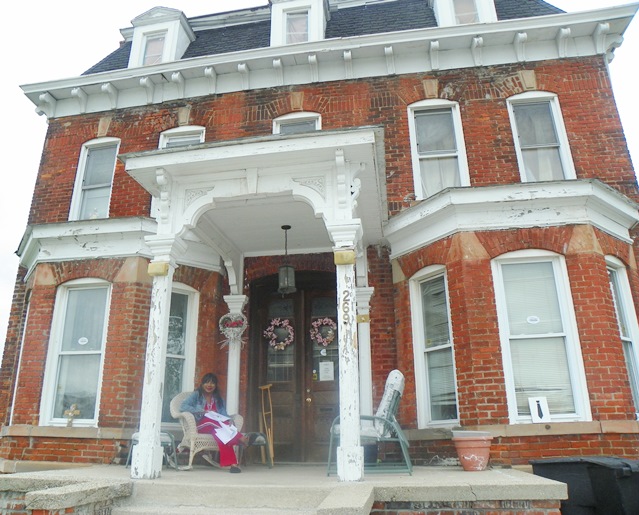
Gwen Mingo lives in her Brush Park home to this day, despite terror tactics that drove most of her neighbors out.
Gwen Mingo, former head of the Brush Park CDC, said, “They tried to kill you from the inside just like they tried to destroy the buildings . They threw the people out, smashing them to the ground like a piece of trash.”
Originally the stated legal purpose of urban renewal was to clear away slums and to “provide a decent home for every American family.” It expanded to allow government to seize the property of the poor and middle class in order to bring in big business and richer folks under a sociological process called “gentrification. ” This moved people into slums and created greater homelessness for many American families.
Jackie Green declared, “We became homeless for a long time. You had to sleep here and there in vacant houses.”
In this case too there have been violations of the law. Urban renewal programs have received federal funding from the U.S. Department of Housing and Urban Development (HUD ). Part of the legal mission of HUD is to “address the challenge of homelessness,” and that would mean not creating homelessness. Another part of the legal purpose is “to move people from renting to home ownership.” HUD-funded urban renewal has moved people out of the homes they own into a place they can rent, if they can find one.
BLATANT RACIAL DISCRIMINATION
There have been other violations.
During a court case, attorney Cynthia Gaither presented city records specifying all Brush Park residents slated for displacement were Black, while Caucasians were allowed to stay.
Gaither said, “The plan speaks for itself. It tells of segregation,” adding this was contrary to state and federal law. When Andrew Cuomo, then HUD Director, was asked about this during a public press conference at the 1999 NAACP convention, he said if the city plan was promoting segregation, his organization was not only legally obliged to cut off funding, but obligated to sue the city.
He requested information for his staff to look into. The staff got it, but HUD never gave a response.
Legally when people were displaced by the government action in urban renewal, local governments had been obligated to relocate them in standard housing comparable to the homes they lost.
Brush Park resident Betty Clark stated in 2003 that she had signed statements from 800 people saying that they had been displaced from their homes without receiving any relocation benefits.
At the time, Detroit City Councilwoman Maryann Mahaffey said there was not enough decent housing residents could afford. In the meantime, public housing projects were being closed under the Clinton Administration’s HOPE VI program.
City officials have ruled that when residents move out of their homes on their own, the city had no legal obligation to relocate them. Historically this gave city officials an incentive to make life in urban renewal areas so miserable that residents would feel compelled to leave by cutting city services necessary for health and safety.
‘TERRORISM USED TO DRIVE PEOPLE OUT” OF BRUSH PARK
Some claimed that in Brush Park city bureaucrats went further.
In 2001 Detroit City Councilman Clyde Cleveland said, “Terrorism was used to drive people out.” He stated city bulldozers tore down the house of Barbara Womack. They also tore down the house of Nathaniel and Annie Jackson, forcing these two senior citizens to live in their garage. Also in 2001, Brush Park resident Edith Woodberry told the city council that helicopters in the sky were creating fires in vacant historic homes.
She added the fire department never responded. Echoing the feelings of many area residents, she said, “I think somebody ought to go to jail for it. ”
In 2003 the Detroit Fire Department specifically refused to investigate fires that its own officials classified as arson. Spokespersons claimed the department did not have the resources. However, one official identifying himself as Captain Baxter said the city was not going to request help from the state and federal government. Residents felt terrorized, because they feared such fires might spread to occupied homes.
Mingo stated that seeking homeless people displaced by urban renewal were seeking shelter in one of the buildings that burned down.
Mingo said, “They barely escaped with their lives.”
When asked if she had any idea who might have set the fires, Mingo answered with an intellecual concept that went back to Roman law, “Who would benefit from the fire?” She indicated this would benefit the developers, who could take the land now reserved for the historic homes. Other residents suggested they would also benefit if the residents were frightened enough to move out.
Ten years ago some felt that because of Mingo’s position on the Citizens District Council and her outspokenness on behalf of the people, Mingo herself was subjected to terrorism, if not attempted murder.
Mingo stated on November 12, 2001, two days after she won a Freedom Award for her advocacy in Brush Park, an “odd fire” broke out in her building.
“I called the fire department,” she said, “but nobody came.”
In 2005 contractors from the Detroit Economic Growth Corporation just happened to keep knocking down holes in the gas main next to her home. When asked about it, an employee of the electric company stated this was a fire hazard. Community leaders throughout the city came to her home and held what they called a “vigil” to prevent further danger to herself and her family.
Mingo said the gas main was later fixed by the electric company. She added electric company employees urged the city contractors not to get involved in the repair, because their continuous wrecking of the gas main was like “deja vu.”
A few years later some residents doubted that it was a complete coincidence that a hit and run driver rammed Mingo’s car into a lamp post less than a week after she filed suit against city policies.
Civil rights activist Arnetta Grable, head of the Original Coalition Against Police Brutality, said at the 2005 vigil that what was happening to Mingo was part of a general pattern of violence against community leaders trying to prevent government takeover of people’s land.
AREA’S ENVIRONMENT RUINED
State and city bureaucrats may have ruined the environment of the entire area, using MDEQ funds to do it.
Residents say those who tore down historic houses recklessly violated standards protecting people’s life and breath. According to the National Safety Council, many buildings constructed before the 1970’s contained dangerous levels of asbestos. Mingo said that when the houses were torn down, adequate measures were not taken to prevent the spread of the asbestos. As a result, she said, many residents suffered from breathing problems. “One resident in her 80s can hardly breathe,” she said then. “My son, who had his asthma cleared up, can [now] hardly breathe.” She added instead of cleaning up the asbestos, “We have seen workers put soil on it to cover it up.”
Years later, Mingo said that on a number of blocks people died just as the city sought to take their land.
While interviewing those involved with the state, it did not seem possible to get a consistent answer or even a coherent one. Bridget Morse, site scientist for Environ Matrix, handling air monitoring, maintained, “There is absolutely no asbestos.” When asked why the company handling the demolition, Richter’s Contracting, had put up signs saying, “Danger Asbestos Hazard,” she said “They are just there to prevent people from going in [to the area around the houses].”
In short, she was reassuring residents that the state contractor was deceiving them and the public couldn’t always trust what they said.
However, Thomas Vincent, an MDEQ inspector, told a different story. He did not deny the asbestos existed but maintained the company was following federal regulations to prevent the asbestos from spreading beyond the demolition area. He claimed this was accomplished by keeping the area wet.
Photos published in The Michigan Citizens revealed the land around the demolition was dry. When asked about this a few days later, Vincent said the land only had to be wet when the demolition moved the asbestos around.
Vincent admitted that when the land dried up, the wind might blow the asbestos away, but added such a situation was not covered under federal regulations. In short, it was possible that the safety of residents might be gone with the wind.
Mingo raised questions about whether the flying asbestos might injure the affluent people Mayor Duggan want to move in and gentrify the area. Some might wonder whether this might even affect sports fans going into Mike Ilitch’s Comerica Park.
It looks like urban renewal in the past has not been “developing” Brush Park so much as looting it. It looks like the Citizens District Council was not “hindering” development, but with its dedicated and courageous members was serving as a watch dog to prevent improper and illegal activities.
It is clear that looters do not like watch dogs. It might be good to grant the past request of Brush Park residents, and set up a federal grand jury which can investigate the abuses. It might also look into Kevyn Orr’s illegal order to kill the watchdogs.




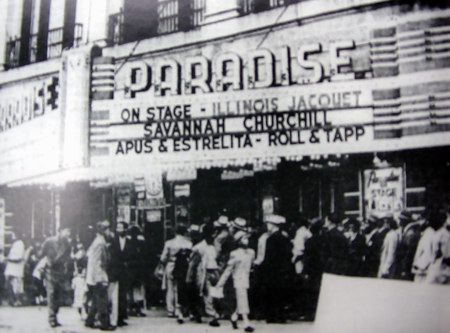
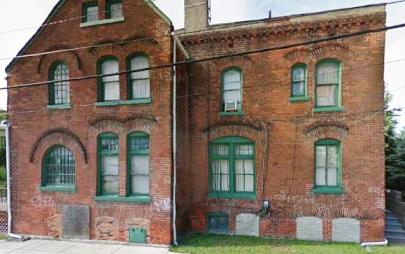


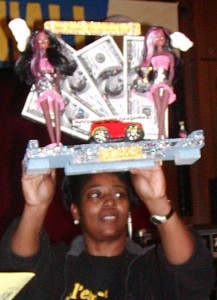

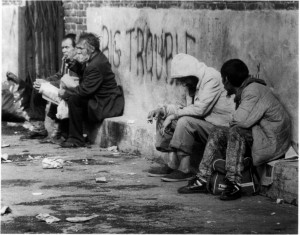




I need to contact Ms. Mingo….can you help? Old friend, Alina from Hubbard- Richard, Aug. 2016
WHAT WAS DONE TO “GWEN MINGO” BY THE FEDERAL DEFINITION OF “TERRORISM” CAN ONLY BE DESCRIBED AS “A GOVERNMENT ACTIVE IN PERFORMING TERRORISM ON IT’S PUBLIC”??
***OF THE PEOPLE BY THE PEOPLE AND FOR THE PEOPLE*** SEEMS TO HAVE BEEN LOST AND A “NEW PAST” BEGINS “TODAY”???
P.S. THE ***”FOR THE PEOPLE”*** SECTION WAS LOST IN THE BATTLE!!
THE INDIGENOUS POPULATION WAS NOT INCLUDED THEN AND STILL IS NOT INCLUDED TODAY. THE ONLY DIFFERENCE IN THE ROMAN GOVERNMENT AND THE GOVERNMENT TODAY IS THE WAY THAT THEY DRESS!!! INTERESTING ??????
Unfortunately, I must agree with Keith Hines’ assessment! I have been personally familiar with the situation for upwards of the past 20 years.